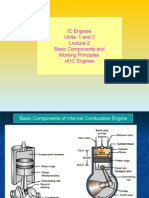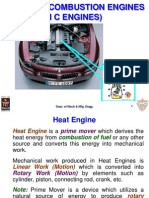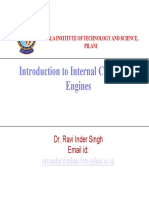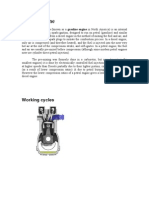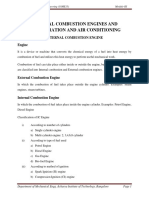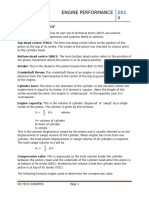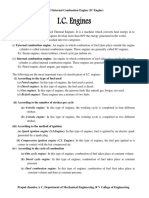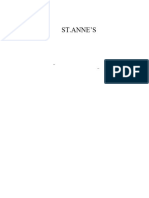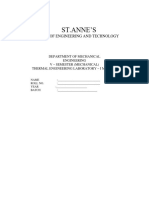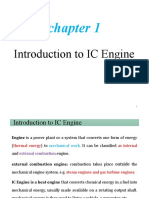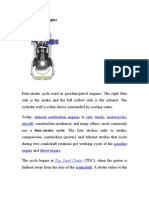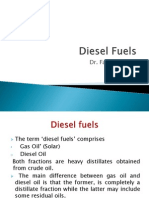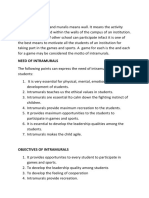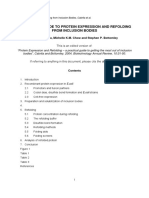Autonext Study Material 1 (Engine) PDF
Autonext Study Material 1 (Engine) PDF
Uploaded by
Abhishek JainCopyright:
Available Formats
Autonext Study Material 1 (Engine) PDF
Autonext Study Material 1 (Engine) PDF
Uploaded by
Abhishek JainOriginal Title
Copyright
Available Formats
Share this document
Did you find this document useful?
Is this content inappropriate?
Copyright:
Available Formats
Autonext Study Material 1 (Engine) PDF
Autonext Study Material 1 (Engine) PDF
Uploaded by
Abhishek JainCopyright:
Available Formats
AutoNext
(A UNIT OF ENGINEERS HERITAGE TRUST)
STUDY MATERIAL
ENGINE
Study Material- 1 [Engine]
Page no. 2
STUDY MATERIAL -1
ENGINE
INDEX
CONTENT
PAGE NO
1.
INTRODUCTION
2.
ENGINE CLASSIFICATION
3.
4 STROKE & 2 STROKE ENGINE
11
4.
ENGINE PARTS & COMPONENTS
13
5.
DIESEL ENGINE
15
6.
PETROL ENGINE
18
7.
INTAKE SYSTEM
20
By - AUTO-NEXT
Website: www.groupautonext.org
Study Material- 1 [Engine]
Page no. 3
INTRODUCTION:
Engine is source of power for the car that makes
the car to move. Engine transforms the Chemical
Energy of fuel into thermal energy and uses this
energy to produce mechanical power. This power
is transmitted to the road wheels with the help of
transmission system
ENGINE SIZE
The displacement of all pistons (Area of piston x Stroke length x
Number of Cylinders) measured in cubic centimeters ( C.C).
C.C = D/4 x l x n Cm
Where D = Bore Diameter in centimeter
l = Stroke length in centimeter
n = Number of Cylinders.
BRAKE HORSE POWER (B.H.P)
Brake Horse Power is the unit of measuring power developed by an
engine. It is the actual power delivered at the flywheel of the engine.
B.H.P of the engine depends on it torque and engine speed (R.P.M).
Higher the B.H.P, more is the power of an engine.
By - AUTO-NEXT
Website: www.groupautonext.org
Study Material- 1 [Engine]
Page no. 4
TORQUE
Torque = Force x Distance
In engine the torque is equal to force of which the piston moving
down multiplied by the distance from the center of the crank pin to
the centre of the crank shaft.
COMPRESSION RATIO
Compression Ratio compares the volume of air in the cylinder
before Compression with volume of air after compression.
Compression Ratio:
For Petrol Engines, generally, 8 to 10: 1
For Diesel Engines, generally, 17 to 24: 1
TOP DEAD CENTRE (T.D.C)
T.D.C means the piston is at its top most position in the cylinder
bore.
BOTTOM DEAD CENTRE (B.D.C)
B.D.C means the piston is at its bottom position in the cylinder
bore.
VOLUMETRIC EFFICIENCY
It is the volume of air and fuel mixture drawn into the cylinder at
normal atmospheric pressure and temperature to the piston
displacement.
Volumetric efficiency = Volume of Air and fuel Mixture at normal
atmospheric pressure and temperature / Piston Displacement (S.V)
By - AUTO-NEXT
Website: www.groupautonext.org
Study Material- 1 [Engine]
Page no. 5
CLASSIFICATION OF ENGINE
Engines May be Classified according to:
1. Engine Cycle
2. Number of strokes
3. Fuel Used
4. Type of Ignition
5. Number and Arrangement of Cylinders
6. Number and Arrangement of Cylinders
a) Engine Cycle
The two commonly used cycles on which the I.C. engines operate
are:
a) Otto Cycle
By - AUTO-NEXT
Website: www.groupautonext.org
Study Material- 1 [Engine]
Page no. 6
b)
Diesel Cycle
B) Number of strokes:
Automobile engines are classified as 2-Stroke engine or 4-Stroke
engine according to the number of strokes to complete a cycle.
In 2 stroke engine all the events of the cycle are completed in two
strokes of the piston.
By - AUTO-NEXT
Website: www.groupautonext.org
Study Material- 1 [Engine]
Page no. 7
In 4 stroke engine all the events of the cycle are completed in four
strokes of the piston.
c) Fuel Used
a)Petrol or Gasoline
b)Diesel engine
c)Hybrid
engine
TYPE OF IGNITION:
a) SI Engine: In this type of engine, ignition takes place by means of an electric
spark provided by a spark plug. Petrol or Gasoline Vehicles are
sparking ignition engines.
b) Compression Ignition Engines: In this type of engines, ignition will take place with help of heat
generated by the compressed air in the cylinder. Diesel and Bio
Diesel vehicles are compression ignition engines.
By - AUTO-NEXT
Website: www.groupautonext.org
Page no. 8
Study Material- 1 [Engine]
d) Number and Arrangement of Cylinders:
a) Classification by Number of cylinders
i) Single cylinder engine
ii)Multi-cylinder engine
b) Classification by Arrangement of cylinders
i. INLINE ENGINE
ii. V-SHAPED ENGINE
iii. OPPOSED ENGINE
IV) RADIAL/ROTARY ENGINE
V-SHAPED
They are arranged in a v-shape
INLINE ENGINE
Arranged in a single line or a row
OPPOSED ENGINE
Are arranged in opposed position(180)
By - AUTO-NEXT
RADIAL ENGINE
Are arranged in radial direction
Website: www.groupautonext.org
Study Material- 1 [Engine]
Page no. 9
e) Valve arrangements:
i.
ii.
iii.
iv.
Over Head Valve (OHV) Engines
F Type (Side Valve) Engine
SOHC (Single Over Head Camshaft) engine
DOHC (Double Over Head Camshaft) engine
OVER HEAD VALVE (OHV)
Both inlet and exhaust valves
are arranged on cylinder
head and operated by a cam
shaft
F TYPE (SIDE VALVE) ENGINE
The inlet valves are arranged on the cylinder head.
The exhaust valves are arranged on the cylinder block.
By - AUTO-NEXT
Website: www.groupautonext.org
Page no. 10
Study Material- 1 [Engine]
SOHC (SINGLE OVER HEAD CAMSHAFT) ENGINE
Both inlet and exhaust
valves are arranged on
cylinder head and are
directly operated by a
single camshaft.
DOHC (DOUBLE OVER HEAD
CAMSHAFT) ENGINE
Both inlet and exhaust valves are
arranged on cylinder head and are
independently operated by
different camshafts.
By - AUTO-NEXT
Website: www.groupautonext.org
Study Material- 1 [Engine]
Page no. 11
Working OF four Stroke & two stroke Engine:
4 Stroke Engine:
The four cycles refer to intake, compression, combustion (power), and
exhaust cycles that occur during two crankshaft rotations per power cycle
of the four-cycle engines.
1. INTAKE stroke: the piston descends from the top of the cylinder to the
bottom of the cylinder, reducing the pressure inside the cylinder. A
mixture of fuel and air, or just air in a diesel engine, is forced by
atmospheric (or greater) pressure into the cylinder through the intake
port. The intake valve(s) then close.
2. COMPRESSION stroke: With both intake and exhaust valves closed, the
piston returns to the top of the cylinder compressing the air, or fuel-air
mixture into the combustion chamber of the cylinder head.
3. POWER stroke: While the piston is close to Top Dead Center, the
compressed airfuel mixture in a gasoline engine is ignited, usually by a
By - AUTO-NEXT
Website: www.groupautonext.org
Page no. 12
Study Material- 1 [Engine]
spark plug, or fuel is injected into the diesel engine, which ignites due to
the heat generated in the air during the compression stroke. The
resulting massive pressure from the combustion of the compressed fuelair mixture forces the piston back down toward bottom dead centre.
4. EXHAUST stroke: The piston once again returns to top dead center
while the exhaust valve is open. This action evacuates the burnt products
of combustion from the cylinder by expelling the spent fuel-air mixture out
through the exhaust valve(s).
Two Stroke Engine:
The 2-cycle engine comprises of the two strokes. A two-stroke or 2-cycle
engine is a type of internal combustion engine which completes a power
cycle in only one crankshaft revolution and with two strokes, or up and
down movements, of the piston in comparison to a "four-stroke engine",
which uses four strokes to do so. This is accomplished by the end of the
combustion stroke and the beginning of the compression stroke happening
simultaneously and performing the intake and exhaust (or scavenging)
functions at the same time.
Two-stroke engines often provide high
power-to-weight ratio, usually in a
narrow range of rotational speeds
called the "power band", and,
compared to 4-stroke engines, have a
greatly reduced number of moving
parts.
By - AUTO-NEXT
Website: www.groupautonext.org
Page no. 13
Study Material- 1 [Engine]
Components of Engine:
1. Cylinder Head
2. Cylinder Head Gasket
3. Valve
4. Hydraulic Tappets
5. Camshaft
6. Cylinder Block
7. Piston
8. Piston Rings
9. Crankshaft
10. Connecting Rod
11. Main Bearing
12. Fly wheel
13. Oil Sump /Oil Pan
14. Oil Strainer
15. Oil Pump
By - AUTO-NEXT
Website: www.groupautonext.org
Study Material- 1 [Engine]
Page no. 14
FLYWHEEL
The flywheel is equipped to the transmission side of the crankshaft
to maintain the smooth rotation using inertia force and to reduce the
irregularity of the rotational force. The crankshaft is rotated twice per
one of the combustion. At the other strokes, the reversed directional
force shall be needed for the compression, the intake and exhaust. If
there is no flywheel, then the rotational force of the crankshaft shall
be reduced at these strokes. Therefore, when the intervals of the
each combustion stroke are long like in the idling state, the engine
may be stopped.
SPARK PLUG The spark plug ignites at the
compressed mixture to fire it
according to the spark arc by the
high voltage generated from the
ignition coil.
The spark plug contacts, at first,
with the mixture having the similar
temperature of outer atmosphere in
the intake stroke, After that, it
contacts with the exhaust gas over
2000.
By - AUTO-NEXT
Website: www.groupautonext.org
Study Material- 1 [Engine]
Page no. 15
Diesel Engine:
Diesel engines are also known as compression ignition (CI) engines
as these engines do not need an ignition system unlike petrol
engines. The fuel is ignited by the compressed air temperature
developed due to higher compression ratio.
Working of 4 Stroke Diesel Engine:
Intake Stroke (Suction Stroke):
In Diesel engine, air alone is drawn into the cylinder during suction
stroke. During this stroke the piston from T.D.C to B.D.C and the
inlet valve opens and the air is sucked into the cylinder through inlet
valve.
Compression Stroke:
During this stroke the piston moves from B.D.C to T.D.C and the air
in the cylinder
gets compressed. Thus raises the air temperature
between 5000C to 8000C which is0 sufficient to ignite the diesel. The
flash point of the diesel fuel is 340 C.
By - AUTO-NEXT
Website: www.groupautonext.org
Study Material- 1 [Engine]
Page no. 16
Power Stroke (Expansion Stroke):
At the end of compression stroke the diesel is sprayed into the
combustion chamber in fine atomized form. It causes explosion and
expansion of gases which in turn forces the piston to move from
T.D.C to B.D.C.
Exhaust Stroke:
During this stroke the piston from B.D.C to T.D.C and the exhaust
valve opens. Due to the upward movement of the piston the burnt
gases are pushed out.
Classification of Diesel Engines:
a)
b)
Direct Injection (D.I)
Indirect Injection (I.D.I)
Direct Injection (D.I)
In direct injection system the diesel
fuel is injected directly into the
combustion chamber which is
formed on the piston head.
The Advantages are
1. The efficiency is high.
2. The emissions are low.
The Dis-advantage is
The sound levels and vibrations
are higher.
By - AUTO-NEXT
Website: www.groupautonext.org
Page no. 17
Study Material- 1 [Engine]
In Direct Injection (IDI)
In this type of engine the Diesel is
injected into a pre-combustion chamber
which is connected to the main
combustion chamber by a narrow
opening. The initial combustion takes
place in this pre-combustion chamber
then spreads to the main combustion
chamber, thus slower the burning
process.
The Advantage is:
Sound levels and vibrations are reduced
The Dis-advantages are
1. Less Power
2. Less Efficiency
3. More Emissions
By - AUTO-NEXT
Website: www.groupautonext.org
Study Material- 1 [Engine]
Page no. 18
Petrol Engine:
Petrol engines are generally known as Spark Ignition (SI) engines as
these engines need an ignition system to provide a spark to ignite
the fuel and air mixture. The whole process is completed in four
stages.
Working of 4 Stroke petrol Engine
Intake Stroke (Suction Stroke):
The piston moves to B.D.C from T.D.C. causing the suction in side
the cylinder and sucks the air / fuel mixture in the cylinder via the
inlet tract. This stroke takes place during 0-1800.of crankshaft
rotation.
Compression Stroke:
The compression stroke is the second of the four strokes of the
cycle. The Piston Moves from B.D.C to T.D.C with both valves
closed. The air / fuel mixture is therefore compressed in the
combustion chamber as the piston moves up. The temperature and
pressure of the charge increases at the end of this stroke. This
stroke takes place during 1800 - 3600 of crank shaft rotation.
Power Stroke (Expansion Stroke ):
The intense heat and pressure generated by igniting the compressed
air/fuel mixture by spark plug in the cylinder causing pressure to increase
rapidly, this pressure forces the piston down towards the B.D.C with both
valves closed. This is the power stroke. This stroke takes place during
3600 - 5400 of crank shaft rotation.
By - AUTO-NEXT
Website: www.groupautonext.org
Study Material- 1 [Engine]
Page no. 19
Exhaust Stroke:
The exhaust stroke is the last in the cycle. The piston starts moving from
B.D.C to T.D.C after the power stroke. The inlet valve remains closed
while the exhaust valve opens forces the burnt gases to go out through
the exhaust. This stroke takes place during 5400 7200 of crank shaft
rotation.
By - AUTO-NEXT
Website: www.groupautonext.org
Study Material- 1 [Engine]
Page no. 20
INTAKE SYSTEM:
The intake system takes the air to mix with petrol and inhales the mixture
into the cylinder, in the case of petrol engines. In diesel engines air alone
is drawn in to the cylinder.
There are two different kinds of air-intake systems with the diesel engine
as well as with the gasoline-engine:
Naturally aspirated engine: The fresh charge is taken in, immediately
from the outside of the naturally aspirated engine and the exhaust fumes
are removed against the outside condition.
Turbocharging engine: The fresh charge is compressed before it is
taken in to intensify the quantity of charge and thus the power and the
torque.
In intake system, many modifications have taken place to increase the
volumetric efficiency. The volumetric efficiency is used for indicating the
intake ability of the mixture.
Turbo Charger
The purpose of Turbo charging is to achieve an increased performance
and torque of the combustion engine without increasing the size of the
Engine.
The exhaust driven turbine (exhaust turbine) is mounted on a
common shaft with the intake air compression turbine (intake turbine
or Compressor). So as the exhaust turbine rotates, the power is
transmitted through the shaft to the intake turbine which also
therefore rotates.
By - AUTO-NEXT
Website: www.groupautonext.org
Page no. 21
Study Material- 1 [Engine]
When the vehicle is being driven, exhaust gases are expelled from the
cylinders into a casing at great speed. The exhaust driven turbine is
positioned at the top of this casing to take advantage of this force and to
provide a very fast response time. This turbine can reach speeds of up to
230,000 rpm.
The rotation of the intake turbine draws in air and compresses it
between the vanes of an impeller. It is then thrown by centrifugal force
in to a casing which directs the air to the intercooler, from which it
enters the intake manifold.
By - AUTO-NEXT
Website: www.groupautonext.org
Page no. 22
Study Material- 1 [Engine]
WASTE GATE TURBOCHARGER:
This is a valve in the exhaust-gas tract in front of the turbine blade.
The compressor of the turbocharger is driven by exhaust gasses that
are directed through a turbine. To slow the compressor speed the
exhaust gasses are redirected from the turbine through a port in the
exhaust known as a waste gate.
The waste gate is controlled by a pressure activated piston. When
the intake reaches the desired pressure the piston opens the waste
gate and slows the compressor. This in turn lowers the intake
pressure. To raise turbo boost levels beyond the waste gates preset
level we need a way to not let the waste gate actuator see the actual
boost pressure. In the air supply line from the intake manifold to the
waste gate actuator a bleed valve is installed.
VARIABLE TURBINE GEOMETRY (VGT)
Variable Turbine Geometry technology is
commonly used in turbo diesel engines in
recent years. It is primarily used to reduce
turbo lag at low engine speed, but it is also
used to introduce EGR (Exhaust Gas
Recirulation) to reduce emission in diesel
engines. Here, we concentrate on the
former advantage.
By - AUTO-NEXT
Website: www.groupautonext.org
Study Material- 1 [Engine]
Page no. 23
Ordinary turbochargers cannot escape from turbo lag because at low
engine rpm the exhaust gas flow is not strong enough to push the
turbine quickly. This problem is especially serious to modern diesel
engines, because they tend to use big turbo to compensate for their
lack of efficiency.
A Variable Geometry Turbocharger is capable to alter the direction of
exhaust flow to optimize turbine response. It incorporates many
movable vanes in the turbine housing to guide the exhaust flow
towards the turbine. An actuator can adjust the angle of these vanes,
in turn vary the angle of exhaust flow.
At low rpm :
The vanes are partially closed, reducing the area hence accelerating
the exhaust gas towards the turbine. Moreover, the exhaust flow hits
the turbine blades at right angle. Both makes the turbine spins faster.
By - AUTO-NEXT
Website: www.groupautonext.org
You might also like
- Engine Technology NotesDocument63 pagesEngine Technology Notesdupinpastore98100% (1)
- Sounds Great 1 PDFDocument89 pagesSounds Great 1 PDFDiep Thao Dinh73% (15)
- Internal Combustion EnginesDocument14 pagesInternal Combustion EnginesAnonymous 1zFjCuBx100% (1)
- Applied Thermal Engineering: Prof. K. K.SHARMADocument69 pagesApplied Thermal Engineering: Prof. K. K.SHARMAKaran100% (1)
- 4 Petrol EngineDocument7 pages4 Petrol Engineayesha amjadNo ratings yet
- 1 - Internal Combustion EngineDocument6 pages1 - Internal Combustion EngineCamia Empleo100% (1)
- Internal Combustion Engines Chapter 1. IntroductionDocument8 pagesInternal Combustion Engines Chapter 1. IntroductionJerry B CruzNo ratings yet
- Applied ThermodynamicsDocument83 pagesApplied ThermodynamicsKaranNo ratings yet
- IC Engines Unit 4 - TDDocument43 pagesIC Engines Unit 4 - TDchincha chuNo ratings yet
- Unit-I: TO Ic EnginesDocument43 pagesUnit-I: TO Ic EnginesLeo Dev WinsNo ratings yet
- Le2 Basic Components and Working PrinciplesDocument46 pagesLe2 Basic Components and Working Principlessaichandrasekhar_dNo ratings yet
- Applied Thermal EngineeringDocument83 pagesApplied Thermal Engineeringommech2020No ratings yet
- Internal Combustion EngineDocument48 pagesInternal Combustion Enginehamzarashadrajput2000No ratings yet
- Lab - Report - 1 - A - Nifat New NewDocument8 pagesLab - Report - 1 - A - Nifat New NewmoudditNo ratings yet
- At6311 Ac Lab ManualDocument78 pagesAt6311 Ac Lab Manualvivek kumarNo ratings yet
- Introduction IC EnginesDocument8 pagesIntroduction IC EnginesSarmad Altaf Hafiz Altaf HussainNo ratings yet
- Prepared By: Nimesh Gajjar: Construction and Working of I.C. EngineDocument68 pagesPrepared By: Nimesh Gajjar: Construction and Working of I.C. EngineTanpaNamaNo ratings yet
- I C EngineDocument73 pagesI C EngineHarshit AgarwalNo ratings yet
- 4 Stroke Petrol EngineDocument11 pages4 Stroke Petrol EngineAnkit Joshi50% (4)
- IC Engines PPT Lecture No 1Document33 pagesIC Engines PPT Lecture No 1VishweshRaviShrimali100% (1)
- Thermo Ex.4Document5 pagesThermo Ex.4Hafeez AliNo ratings yet
- IC EngineDocument45 pagesIC EngineYashika PuriNo ratings yet
- Ic Engine NotesDocument60 pagesIc Engine Notessamarth motka100% (1)
- EME Notes Unit 1Document11 pagesEME Notes Unit 1SumanranuNo ratings yet
- Updated Unit-2 Fme NotesDocument51 pagesUpdated Unit-2 Fme Notesdipendrapratapsingh455No ratings yet
- Engine: An Engine Is Motor Which Converts Chemical Energy of A Fuel Into The Mechanical EnergyDocument61 pagesEngine: An Engine Is Motor Which Converts Chemical Energy of A Fuel Into The Mechanical EnergyZain Ul AbideenNo ratings yet
- Automative Electronics and Hybrid VehicleDocument34 pagesAutomative Electronics and Hybrid VehicleNIKHIL ASNo ratings yet
- Unit I (IC Engines)Document13 pagesUnit I (IC Engines)prasanthiNo ratings yet
- IME - Module 3-NotesDocument15 pagesIME - Module 3-Notesyuvaraaja25No ratings yet
- Demonstration of Compression and Expansion Process in Engine! Introduction To Internal Combustion Engines!Document49 pagesDemonstration of Compression and Expansion Process in Engine! Introduction To Internal Combustion Engines!SHANTHARAMAN P PNo ratings yet
- Unit 1 Construction and Operation: External Combustion EngineDocument14 pagesUnit 1 Construction and Operation: External Combustion Enginekrishna samNo ratings yet
- Maharashtra State Board of Technical Education Certificate: Mechanical Engineering of Marathwada Mitra Mandal'sDocument16 pagesMaharashtra State Board of Technical Education Certificate: Mechanical Engineering of Marathwada Mitra Mandal's190 208 Rahul DhaneshwarNo ratings yet
- Petrol Engine: Working CyclesDocument7 pagesPetrol Engine: Working CyclesBrijesh Patel100% (1)
- Eme Module IiiDocument35 pagesEme Module IiiPrashanth JNo ratings yet
- Chap 3Document57 pagesChap 3jatadharaNo ratings yet
- Module - 3 Internal Combustion Engines and Refrigeration and Air ConditioningDocument18 pagesModule - 3 Internal Combustion Engines and Refrigeration and Air Conditioninghimanshu malik100% (1)
- Engine Performance TerminologyDocument14 pagesEngine Performance Terminologybchisenga861No ratings yet
- Yy Y Yy" Y! Y YyyDocument14 pagesYy Y Yy" Y! Y YyyVenkatachalam AnnamalaiNo ratings yet
- I C - Engines-NotesDocument15 pagesI C - Engines-Notessuhas_SCEMNo ratings yet
- Chapter 1 - ICEDocument51 pagesChapter 1 - ICEsubNo ratings yet
- Diesel EngineDocument14 pagesDiesel EngineAyşenur Çetin100% (1)
- Basics of EnginesDocument7 pagesBasics of EnginesMian AsimNo ratings yet
- Unit 3Document16 pagesUnit 3Shivanand BurliNo ratings yet
- Lecture Notes ON Internal Combustion Engine: Course Code: Me 4101Document10 pagesLecture Notes ON Internal Combustion Engine: Course Code: Me 4101Mahi100% (1)
- I C Engine TerminologyDocument47 pagesI C Engine TerminologyShubham SharmaNo ratings yet
- Hand Made CarDocument33 pagesHand Made CarSahil DhirNo ratings yet
- Unit 1Document32 pagesUnit 1Rakeshkumarceg100% (1)
- Mini Project PresentationDocument24 pagesMini Project PresentationHarshit SharmaNo ratings yet
- Introduction To IC Engines and IC Engines FundamentalsDocument20 pagesIntroduction To IC Engines and IC Engines FundamentalswanabultiNo ratings yet
- Engine Component Set 5Document17 pagesEngine Component Set 5arif hussainNo ratings yet
- Vehicle Design and Characteristics (Sathybama)Document95 pagesVehicle Design and Characteristics (Sathybama)shaziya mehrinNo ratings yet
- Chapter 02 - Internal Combustion EngineDocument47 pagesChapter 02 - Internal Combustion EngineYsmael Alongan B. MangorsiNo ratings yet
- ME8512-THERMAL ENGINEERING LABORATORY-802275728-THERMAL LAB - 1 - MergedDocument122 pagesME8512-THERMAL ENGINEERING LABORATORY-802275728-THERMAL LAB - 1 - MergedSamar SinghalNo ratings yet
- Thermal Engineering Laboratory IDocument44 pagesThermal Engineering Laboratory Iselvakumar3738sNo ratings yet
- IC Engine PPT ch-1Document73 pagesIC Engine PPT ch-1ashenafi tesfaye100% (1)
- Ic EnginesDocument46 pagesIc Enginesranjith kumarNo ratings yet
- I.C. Engines: (I) According To The Type of Fuel UsedDocument15 pagesI.C. Engines: (I) According To The Type of Fuel UsedSreejith VaneryNo ratings yet
- FourDocument13 pagesFourStanly Anto KanichaiNo ratings yet
- Comparison of Diesel and Petrol EnginesFrom EverandComparison of Diesel and Petrol EnginesRating: 2.5 out of 5 stars2.5/5 (3)
- Southern Marine Engineering Desk Reference: Second Edition Volume IiFrom EverandSouthern Marine Engineering Desk Reference: Second Edition Volume IiNo ratings yet
- Neon Invest Stocks EtfsDocument9 pagesNeon Invest Stocks Etfsjarchowsilvia26No ratings yet
- Medical Council of Inida Declaration Form 2010-2011for FacultyDocument9 pagesMedical Council of Inida Declaration Form 2010-2011for FacultydrtpkNo ratings yet
- Unisim SimulationDocument30 pagesUnisim SimulationZahid HussainNo ratings yet
- Critically Ill Severe Hypothyroidism: A Retrospective Multicenter Cohort StudyDocument9 pagesCritically Ill Severe Hypothyroidism: A Retrospective Multicenter Cohort StudyBelajarNo ratings yet
- Biomolecules 13 00441 v2Document23 pagesBiomolecules 13 00441 v2Sarah SalaNo ratings yet
- From IntramuralsDocument8 pagesFrom IntramuralsTechbit GamerzNo ratings yet
- 400 00101509en Specflex NC 630 TdsDocument3 pages400 00101509en Specflex NC 630 Tdshell90No ratings yet
- PU Foam Injection Product BrochureDocument4 pagesPU Foam Injection Product BrochureMiscNo ratings yet
- Nitric Acid (SUMMARY CHEMISTRY CHAPTER)Document2 pagesNitric Acid (SUMMARY CHEMISTRY CHAPTER)the lillyNo ratings yet
- 55th International Mendeleev Olympiad 20Document6 pages55th International Mendeleev Olympiad 20Thành Lê MậuNo ratings yet
- Frontline Defense Against Network AttackDocument15 pagesFrontline Defense Against Network AttackRyan Roman CatogNo ratings yet
- Chicha Street Food MenuDocument2 pagesChicha Street Food MenuChiCha StreetFoodNo ratings yet
- Label Marinated Deboned BangusDocument4 pagesLabel Marinated Deboned BangusCharie C. OrbocNo ratings yet
- LM 1875Document17 pagesLM 1875Rudy ArmannNo ratings yet
- Land Aquisition Act 2013Document21 pagesLand Aquisition Act 2013Shruti Sinha100% (2)
- Aromatherapy With Citrus Aurantium Oil and Anxiety During The First Stage of Labor Masoumeh NamDocument6 pagesAromatherapy With Citrus Aurantium Oil and Anxiety During The First Stage of Labor Masoumeh NamSerli W SafitriNo ratings yet
- Guia Practica para Proteinas en Cuerpos de InclusionDocument15 pagesGuia Practica para Proteinas en Cuerpos de InclusionMarco Ku CenturionNo ratings yet
- MOS Installation of Underground and Above Fuel PipeDocument110 pagesMOS Installation of Underground and Above Fuel PipeZawirul faizNo ratings yet
- Learning Activity Sheet: ObjectivesDocument7 pagesLearning Activity Sheet: Objectivesjon pantzNo ratings yet
- Teste Şi Fişe de Lucru Pentru Clasele Ii-Iv: Test Paper 4 GradeDocument15 pagesTeste Şi Fişe de Lucru Pentru Clasele Ii-Iv: Test Paper 4 GradeclaudiaNo ratings yet
- Queer Sex IntimacyDocument105 pagesQueer Sex IntimacyDenisseNo ratings yet
- Katrina Castro Resume - Katrinas ResumeDocument2 pagesKatrina Castro Resume - Katrinas Resumeapi-467840192No ratings yet
- Bcbs Fep Appeal Form Medical Necessity Hearing AidsDocument4 pagesBcbs Fep Appeal Form Medical Necessity Hearing Aidssml626No ratings yet
- Miriam Tillinger CVDocument6 pagesMiriam Tillinger CVapi-222275167No ratings yet
- Mtap 2 HematologyDocument15 pagesMtap 2 HematologyNaomi NicoleNo ratings yet
- Acc Unit-22-AnswersDocument10 pagesAcc Unit-22-AnswersGeorgeNo ratings yet
- Urban EconomicsDocument22 pagesUrban EconomicsSaurabh SumanNo ratings yet
- Biology 9 Pipette and Micropipette Use PipettesDocument4 pagesBiology 9 Pipette and Micropipette Use PipettesHi Tech Calibration ServicesNo ratings yet
- Ayurveda Food Combining - Banyan BotanicalsDocument6 pagesAyurveda Food Combining - Banyan BotanicalsRajVeerNo ratings yet










